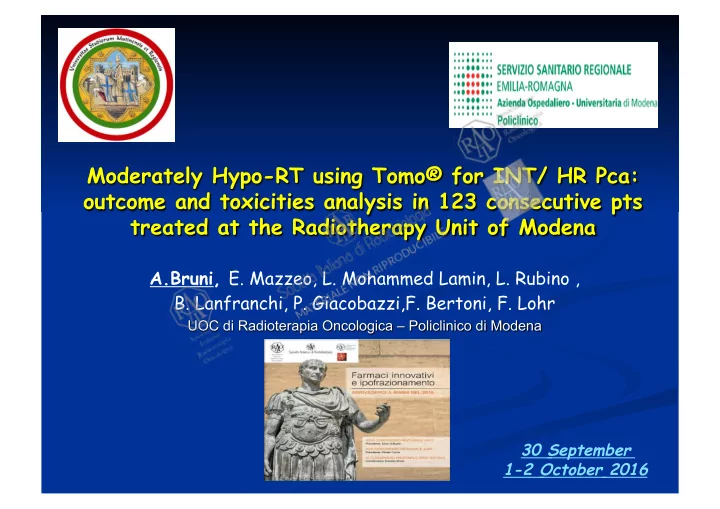

30 September 1-2 October 2016
123 consecutive pts treated by Hypofractionated Radiotherapy with curative intent July 2008 – September 2015 Median Age 73 Yrs GPS <7 in 32 pts KPS 90-100 91,8% =7 in 50 pts Mean iPSA=19,5 ng/mL >7 in 41 pts 18 45 29 20 0 112 2 3 1 5 0 11 20 48 30 25 0 123
RT total treatment time: mean 42 ±5,9SD days Median total doses: 2,3 – 3,82 PTV1 ( Prostate ): 70 Gy(range 57,3-75 Gy) Gy/Die PTV2 ( Prostate+VS ): 58,8Gy(range 54-70 Gy) PTV3 (P+VS+Pelvis) : 50,4 Gy(range 50,4-58,8) SIB 83% All pts completed the planned RT treatment ± ADT Concomitant ADT in 71,5% of pts (88/123) Prophilactic Pelvis RT in 61,7% of pts (76/123) Mean FUP 39,6 mesi (range 4,0-84,7 mesi)
91,0 +/- 3,0% ES 89,2 +/- 3,2%ES 83,0 +/- 5,1% ES 81,8% +/- 5,1% ES
93,3 +/- 2,7% ES 88,1 +/- 4,5% ES Univariate Analysis Multivariate Analysis
Univariate Analysis OS DMFS DFS Età NS NS NS KPS NS NS NS Gleason PS NS p <0,03 p < 0,0001 T NS NS NS N p <0,14 p <0,10 p <0,0001 iPSA NS NS NS Risk Class NS NS p <0,006 Dose RT NS NS NS WPRT NS p <0,08 p < 0,001 OT NS NS p <0,005 Psa Nadir p< 0,12 p <0,11 p <0,08
Univariate Analysis 98,7+/- 1,2 ES 88,6 +/- 4,9 ES 98,9 +/- 1,1 ES 83,2 +/- 5,5 ES 90,9 +/- 8,7 ES 79,5 +/- 13,1 ES 89,6 +/- 7,0 ES 58,7 +/- 15,6 ES
Univariate Analysis 100% +/- 0,0 ES 93,3% +/- 6,4ES 100 +/- 0,0 93,3 +/- 6,4 ES 95,5+/-3,1 ES 89,5 +/- 6,5 ES 95,5% +/- 3,1 ES 89,5% +/- 6,5 ES 92,0 +/- 4,4 64,2 +/- 10,1 ES 92,0% +/- 4,4 ES 64,2% +/- 10,1 ES
Univariate Analysis Disease Free Survival 98,4% +/- 1,4 ES 85,0% +/- 5,1 ES 72,7% +/- 13,4 ES 31,8% +/- 23,6 ES
Univariate Analysis 100% +/- 0,0 ES 90,9% +/- 8,7 ES 100% +/- 0,0 ES 94,1% +/- 5,7 ES 80,3% +/- 7,5 ES 80,3% +/- 7,5 ES
RESULTS-7 Multivariate Analysis DFS Gleason PS P<0,03 Nodal P<0,006 Involvement
RESULTS-8 Acute Toxicities Three pts had G3 acute Rectal toxicities requiring short term RT interrumption. Four pts had G3 acute bladder toxicities with macrohematuria Late Toxicities TOSSICITA’ TARDIVA Nine pts had G3 late Rectal bleeding requiring temporarily hospitalization. ≥ G3 3,3% Three pts had G3 late GU toxicities with persistent macrohematuria; 1 pt had G4 toxicity requiring cystectomy
DISCUSSION -1 Type RT Hypo Risk Study of End-point #Pts RTs Class Dose BED1.5 Study BCDF US, Miami Sup 303 All 76 70.2@2.7 84.4 15%@5yr RFS Int- HYPRO Sup 820 78 64.6@3.4 90.4 10%@5yr high 5yr-DFS US, Duke Non-Inf 1115 Low 73.8 70@2.5 80 HR<1.52 5yr-DFS PROFIT Non-Inf 1206 Int 78 60@3 77 HR<1.32 CHHiP Non-Inf BFR or CF 60@3/ 3216 All 74 77 Trial HR<1.20 57@3 Int-High Courtesy of Dr. D’Angelillo (modified)
DISCUSSION -2 Results Type of RT Hypo Study End-point RTs Study BED1.5 RTs RT Hypo BCDF US, Miami Sup 76 84.4 21.4% 23.3% 15%@5yr HYPRO Sup RFS 10%@5yr 78 90.4 77.1% 80.5% 86.3% 5yr-DFS US, Duke Non-Inf 73.8 80 85.3% HR 0.85 HR<1.52 (0.67-1.14) 79% 5yr-DFS PROFIT Non-Inf 78 77 79% HR 0.99 HR<1.32 (0.83-1.19) 90.6% BC or CF CHHiP Trial Non-Inf 74 77 88.3% HR 0.84 HR<1.208 (0.68-1.03) 5yr-DFS 81,8% 80 Courtesy of Dr. D’Angelillo (modified)
DISCUSSION -3 %GU toxicity ( ≥ G2) %GI toxicity ≥ G2 RT Hypo Study RTs BED3 H H H H US, Miami 76 80 nr 21.5 nr 18.1 HYPRO 78 82.7 23 41.3 13 21.9 US, Duke 73.8 77 27 29.7 10.7 22.4 PROFIT 78 72 4 2.1 0.7 1.3 CHHiP 74 72 49 2 38 3 Courtesy of Dr. D’Angelillo (modified)
CONCLUSIONS Moderately Hypofractionated IG-IMRT using Tomotherapy was well tolerated, efficient and safe in terms of toxicities and clinical outcomes ( 5-Yr OS=83,0%, 5Yr DFS =81,8% ) Just 3 pts had to stop RT treatment (3-6 days) demonstrating an excellent tolerability profile even of RT treatment is associated to ADT Any prognostic factor was found for DMFS e OS, but Gleason Pattern Score and Nodal Involvement were found to be statistically significant indipendent prognostic factors in terms of DFS A longer follow-up is needed to confirm these findings waiting for the results of the «on-going» Phase III RCTs
Recommend
More recommend